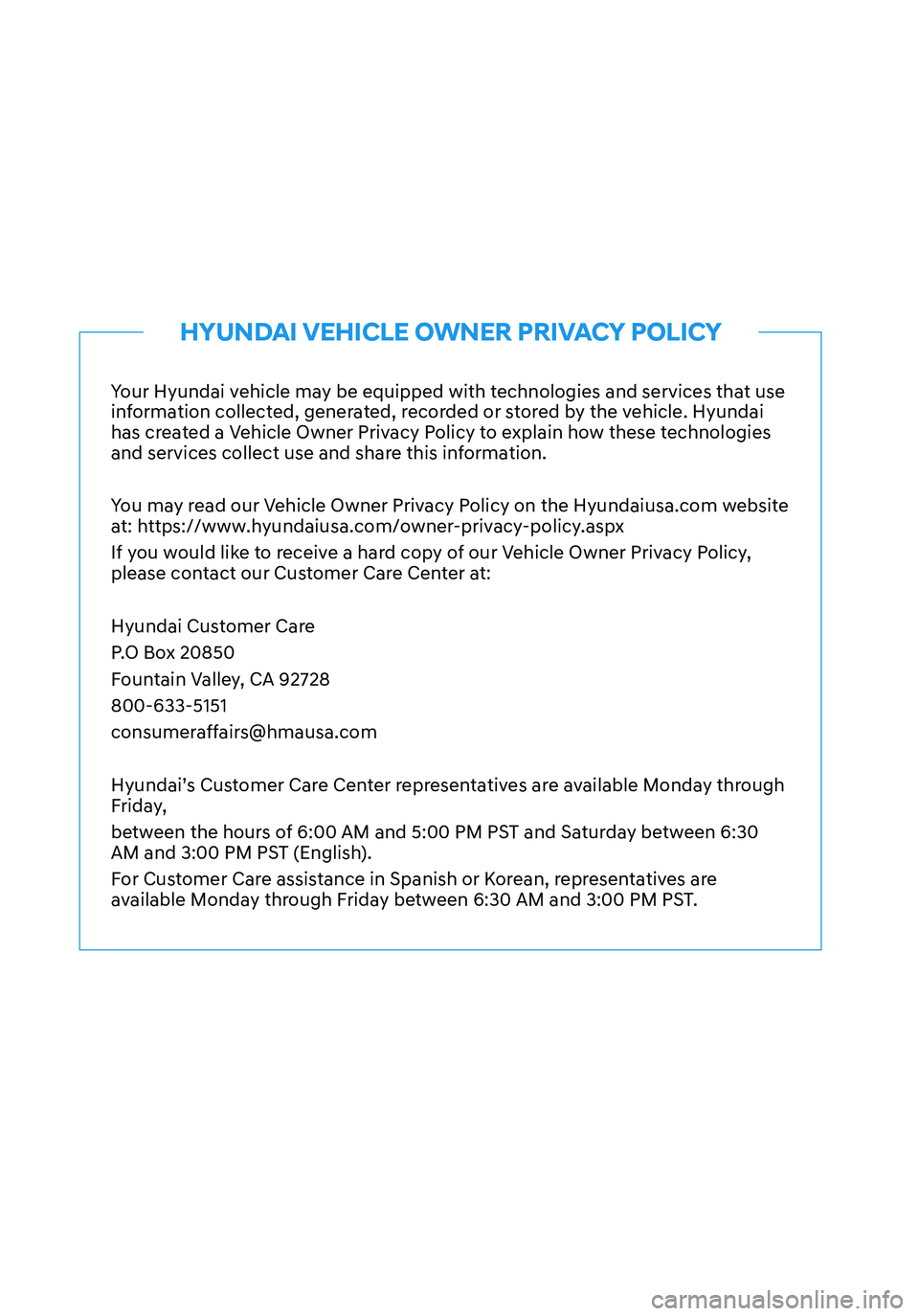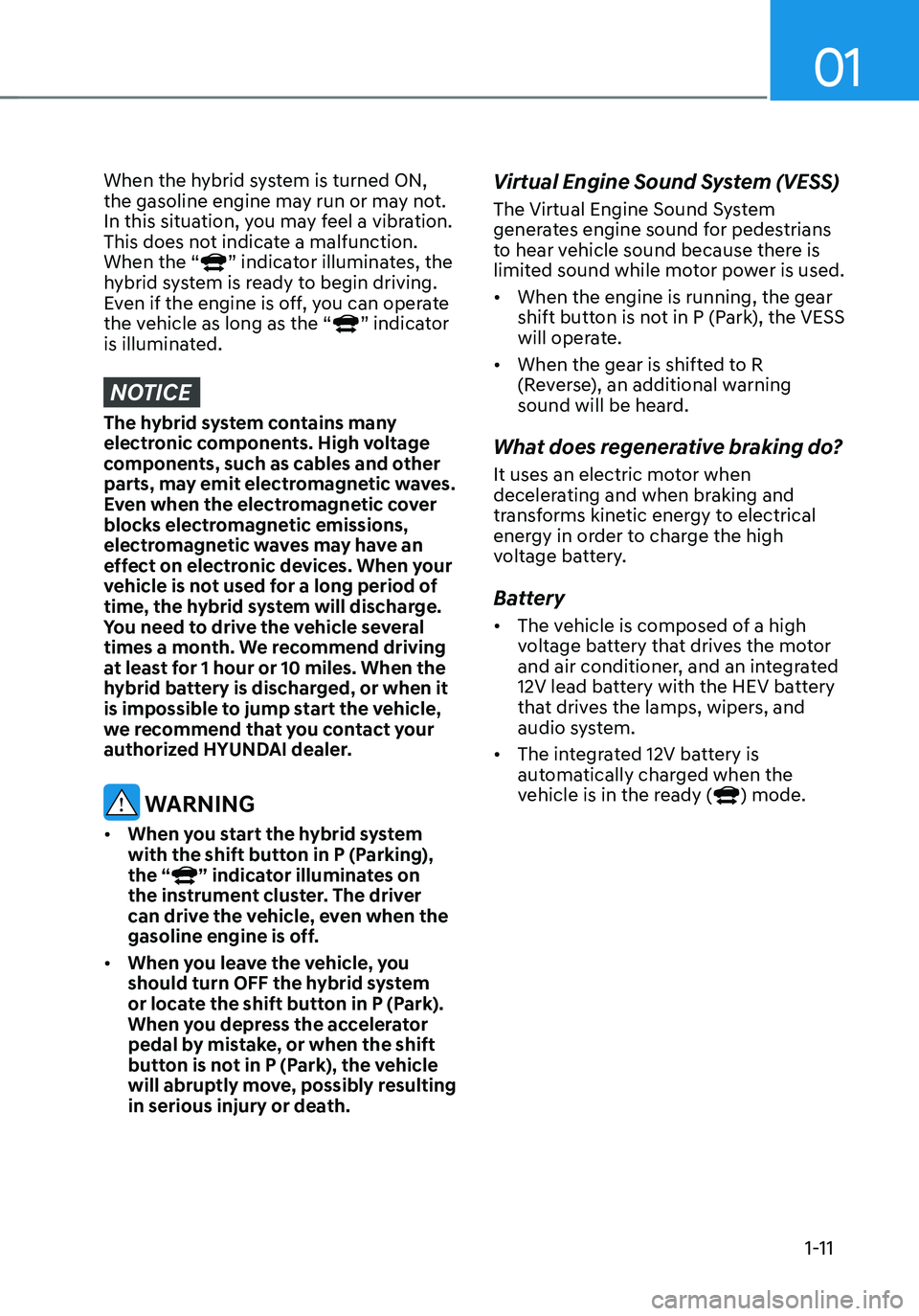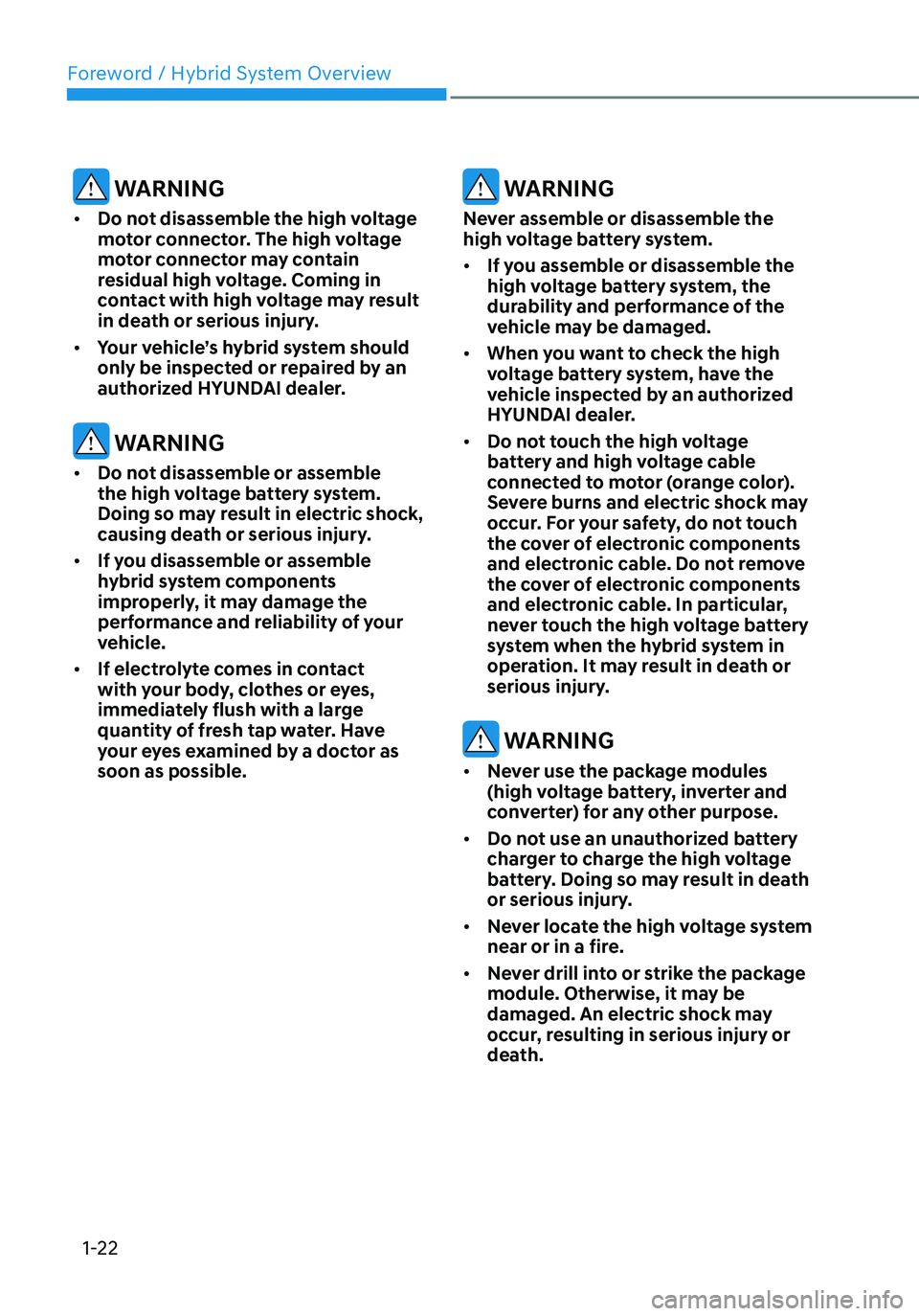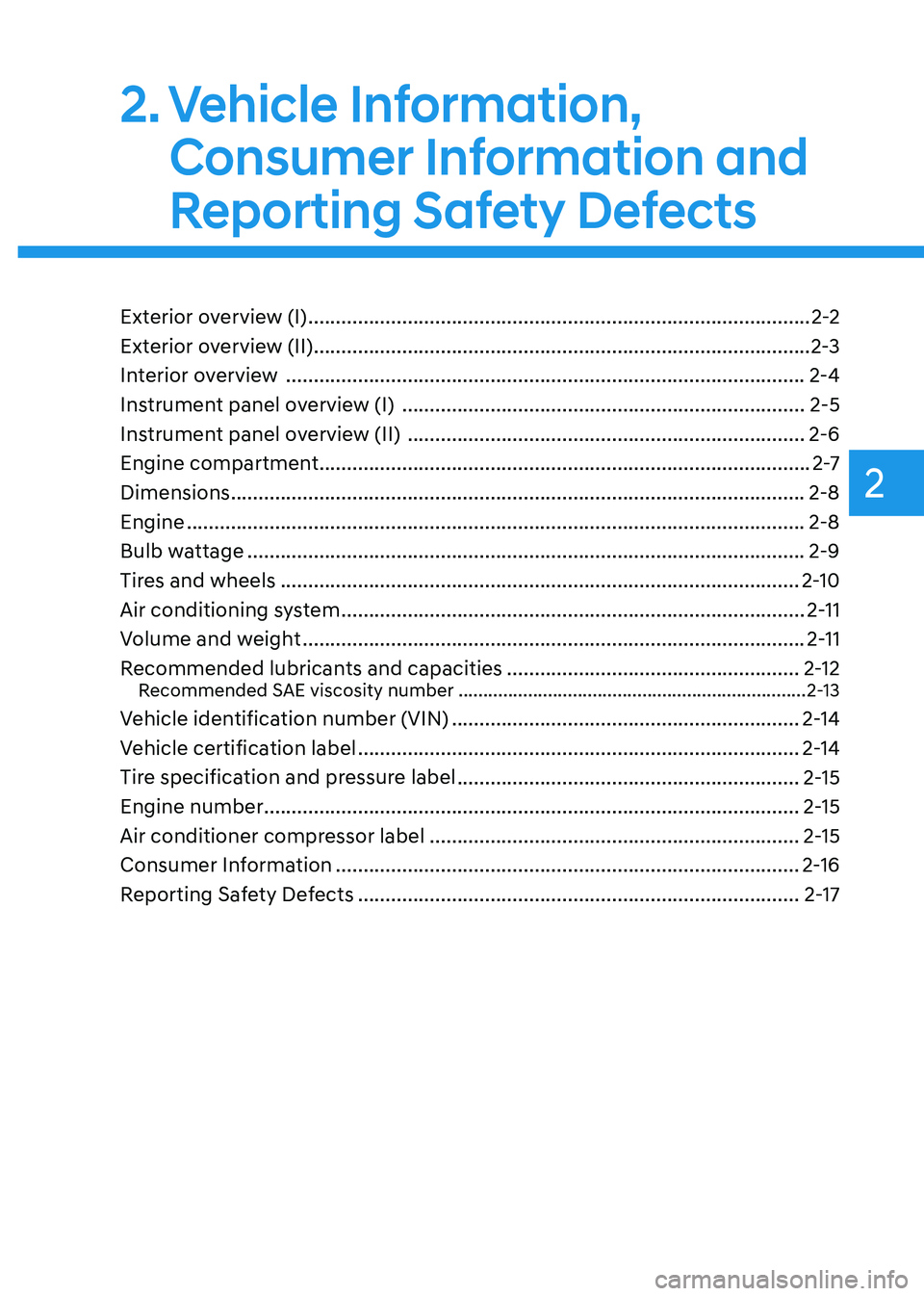2021 HYUNDAI TUCSON HYBRID Air
[x] Cancel search: AirPage 4 of 630

Your Hyundai vehicle may be equipped with technologies and services that use
information collected, generated, recorded or stored by the vehicle. Hyundai
has created a Vehicle Owner Privacy Policy to explain how these technologies
and services collect use and share this information.
You may read our Vehicle Owner Privacy Policy on the Hyundaiusa.com website
at: https://www.hyundaiusa.com/owner-privacy-policy.aspx
If you would like to receive a hard copy of our Vehicle Owner Privacy Policy,
please contact our Customer Care Center at:
Hyundai Customer Care
P.O Box 20850
Fountain Valley, CA 92728
800-633-5151
[email protected]
Hyundai’s Customer Care Center representatives are available Monday through
Friday,
between the hours of 6:00 AM and 5:00 PM PST and Saturday between 6:30
AM and 3:00 PM PST (English).
For Customer Care assistance in Spanish or Korean, representatives are
available Monday through Friday between 6:30 AM and 3:00 PM PST.
HYUNDAI VEHICLE OWNER PRIVACY POLICY
Page 12 of 630

Foreword / Hybrid System Overview
1-8
VEHICLE DATA COLLECTION AND EVENT DATA RECORDERS
This vehicle is equipped with an event data recorder (EDR). The main purpose of
an EDR is to record, in certain crash or near crash-like situations, such as an air bag
deployment or hitting a road obstacle, data that will assist in understanding how a
vehicle’s systems performed. The EDR is designed to record data related to vehicle
dynamics and safety systems for a short period of time, typically 30 seconds or less.
The EDR in this vehicle is designed to record such data as:
• How various systems in your vehicle were operating;
• Whether or not the driver and passenger safety belts were buckled/fastened;
• How far (if at all) the driver was depressing the accelerator and/or brake pedal; and,
• How fast the vehicle was traveling.
These data can help provide a better understanding of the circumstances in which
crashes and injuries occur. NOTE: EDR data are recorded by your vehicle only if a
non-trivial crash situation occurs; no data are recorded by the EDR under normal
driving conditions and no personal data (e.g., name, gender, age, and crash location)
are recorded. However, other parties, such as law enforcement, could combine the
EDR data with the type of personally identifying data routinely acquired during a crash
investigation.
To read data recorded by an EDR, special equipment is required, and access to the
vehicle or the EDR is needed. In addition to the vehicle manufacturer, other parties,
such as law enforcement, that have the special equipment, can read the information if
they have access to the vehicle or the EDR.
Page 15 of 630

01
1-11
When the hybrid system is turned ON,
the gasoline engine may run or may not.
In this situation, you may feel a vibration.
This does not indicate a malfunction.
When the “
” indicator illuminates, the
hybrid system is ready to begin driving.
Even if the engine is off, you can operate
the vehicle as long as the “
” indicator
is illuminated.
NOTICE
The hybrid system contains many
electronic components. High voltage
components, such as cables and other
parts, may emit electromagnetic waves.
Even when the electromagnetic cover
blocks electromagnetic emissions,
electromagnetic waves may have an
effect on electronic devices. When your
vehicle is not used for a long period of
time, the hybrid system will discharge.
You need to drive the vehicle several
times a month. We recommend driving
at least for 1 hour or 10 miles. When the
hybrid battery is discharged, or when it
is impossible to jump start the vehicle,
we recommend that you contact your
authorized HYUNDAI dealer.
WARNING
• When you start the hybrid system
with the shift button in P (Parking),
the “
” indicator illuminates on
the instrument cluster. The driver
can drive the vehicle, even when the
gasoline engine is off.
• When you leave the vehicle, you
should turn OFF the hybrid system
or locate the shift button in P (Park).
When you depress the accelerator
pedal by mistake, or when the shift
button is not in P (Park), the vehicle
will abruptly move, possibly resulting
in serious injury or death.
Virtual Engine Sound System (VESS)
The Virtual Engine Sound System
generates engine sound for pedestrians
to hear vehicle sound because there is
limited sound while motor power is used.
• When the engine is running, the gear
shift button is not in P (Park), the VESS
will operate.
• When the gear is shifted to R
(Reverse), an additional warning
sound will be heard.
What does regenerative braking do?
It uses an electric motor when
decelerating and when braking and
transforms kinetic energy to electrical
energy in order to charge the high
voltage battery.
Battery
• The vehicle is composed of a high
voltage battery that drives the motor
and air conditioner, and an integrated
12V lead battery with the HEV battery
that drives the lamps, wipers, and
audio system.
• The integrated 12V battery is
automatically charged when the
vehicle is in the ready (
) mode.
Page 26 of 630

Foreword / Hybrid System Overview
1-22
WARNING
• Do not disassemble the high voltage
motor connector. The high voltage
motor connector may contain
residual high voltage. Coming in
contact with high voltage may result
in death or serious injury.
• Your vehicle’s hybrid system should
only be inspected or repaired by an
authorized HYUNDAI dealer.
WARNING
• Do not disassemble or assemble
the high voltage battery system.
Doing so may result in electric shock,
causing death or serious injury.
• If you disassemble or assemble
hybrid system components
improperly, it may damage the
performance and reliability of your
vehicle.
• If electrolyte comes in contact
with your body, clothes or eyes,
immediately flush with a large
quantity of fresh tap water. Have
your eyes examined by a doctor as
soon as possible.
WARNING
Never assemble or disassemble the
high voltage battery system.
• If you assemble or disassemble the
high voltage battery system, the
durability and performance of the
vehicle may be damaged.
• When you want to check the high
voltage battery system, have the
vehicle inspected by an authorized
HYUNDAI dealer.
• Do not touch the high voltage
battery and high voltage cable
connected to motor (orange color).
Severe burns and electric shock may
occur. For your safety, do not touch
the cover of electronic components
and electronic cable. Do not remove
the cover of electronic components
and electronic cable. In particular,
never touch the high voltage battery
system when the hybrid system in
operation. It may result in death or
serious injury.
WARNING
• Never use the package modules
(high voltage battery, inverter and
converter) for any other purpose.
• Do not use an unauthorized battery
charger to charge the high voltage
battery. Doing so may result in death
or serious injury.
• Never locate the high voltage system
near or in a fire.
• Never drill into or strike the package
module. Otherwise, it may be
damaged. An electric shock may
occur, resulting in serious injury or
death.
Page 30 of 630

2. Vehicle Information,
Consumer Information and
Reporting Safety Defects
Vehicle Information, Consumer Information and Reporting Safety Defects
Exterior overview (I) ........................................................................\
...................2-2
Exterior overview (II)
........................................................................\
..................2-3
Interior overview
........................................................................\
......................2-4
Instrument panel overview (I)
........................................................................\
.2-5
Instrument panel overview (II)
........................................................................\
2-6
Engine compartment
........................................................................\
.................2-7
Dimensions
........................................................................\
................................2-8
Engine
........................................................................\
........................................2-8
Bulb wattage
........................................................................\
.............................2-9
Tires and wheels
........................................................................\
......................2-10
Air conditioning system
........................................................................\
............2-11
Volume and weight
........................................................................\
...................2-11
Recommended lubricants and capacities
.....................................................2-12Recommended SAE viscosity number ......................................................................2-13
Vehicle identification number (VIN) ...............................................................2-14
Vehicle certification label
........................................................................\
........2-14
Tire specification and pressure label
..............................................................2-15
Engine number
........................................................................\
.........................2-15
Air conditioner compressor label
...................................................................2-15
Consumer Information
........................................................................\
............2-16
Reporting Safety Defects
........................................................................\
........2-17
2
Page 34 of 630

2-5
02
1. Instrument cluster ..................................4-4
2. Driver’s front air bag .............................3-46
3. Engine Start/Stop button .......................6-8
4. Infotainment system ..Infotainment manual
5. Hazard warning lamp switch .................8-2
6. climate control system .........................5-96
7. Air ventilation seat ................................3-20
8. Seat warmer ..........................................3-18
9. Heated steering wheel ........................5-42
10. Parking Safety button .........................7-136
11. Parking/View button ...........................7-112
12. Transmission shift button .....................6-13
13. EPB (Electronic Parking Brake) switch ..6-22
14. Auto Hold switch .................................6-26
15. Drive mode button ..............................6-48
16. Passenger’s front air bag .....................3-46
17. Glove box ..............................................5-116
18. USB port ...............................................5-128
19. Power outlet ..........................................5-118
20. USB charger ..........................................5-119
21. Wireless charging system pad ............5-120
22. DBC (Downhill Brake Control) button .6-36
The actual shape may differ from the illustration.
ONX4H010005N
INSTRUMENT PANEL OVERVIEW (I)
Page 36 of 630

2-7
02
„„Smartstream G 1.6 T-GDi HEV
The actual engine compartment in the vehicle may differ from the illustration.
ONX4EH090001
1. ECU
2. Engine coolant reservoir .......................9-17
3. Engine coolant reservoir cap ................9-17
4. Inverter coolant reservoir......................9-17
5. Brake fluid reservoir .............................9-20
6. Air cleaner .............................................9-22
7. Engine oil filler cap ................................9-15
8. Engine oil dipstick .................................9-15
9. Windshield washer fluid reservoir ........9-21
10. Fuse box .................................................9-41
11. Invert coolant reservoir cap ..................9-17
ENGINE COMPARTMENT
Page 39 of 630

Vehicle Information, Consumer Information and Reporting Safety Defects
2-10
ItemTire size Wheel
size Inflation pressure
psi (kPa) Wheel lug nut
torque
Kgf·m (N·m)
Normal load
Maximum load
Front RearFront Rear
Full size tire 235/65 R17
7.0J X 17
35 (240) 35 (240) 11~13
(107~127)
235/55 R19 7.5J X 19
NOTICE
• It is permissible to add 3 psi (20 kPa) to the standard tire pressure specification if
colder temperatures are expected soon. Tires typically lose 1 psi (7 kPa) for every
12°F(7°C) temperature drop. If extreme temperature variations are expected,
recheck your tire pressure as necessary to keep them properly inflated.
• An air pressure generally decreases, as you drive up to a high-altitude area above
sea level. Thus, if you plan to drive a high-altitude area, check the tire pressures
in advance. If necessary, inflate them to a proper level (Air inflation per altitude:
+2.4 psi/1 mile (+10 kPa/1 km)).
• Must do not exceed maximum inflation pressure shown on equipped tire
sidewall.
CAUTION
When replacing tires, ALWAYS use the same size, type, brand, construction and
tread pattern supplied with the vehicle. If not, it can damage the related parts or
make it work irregularly.
TIRES AND WHEELS